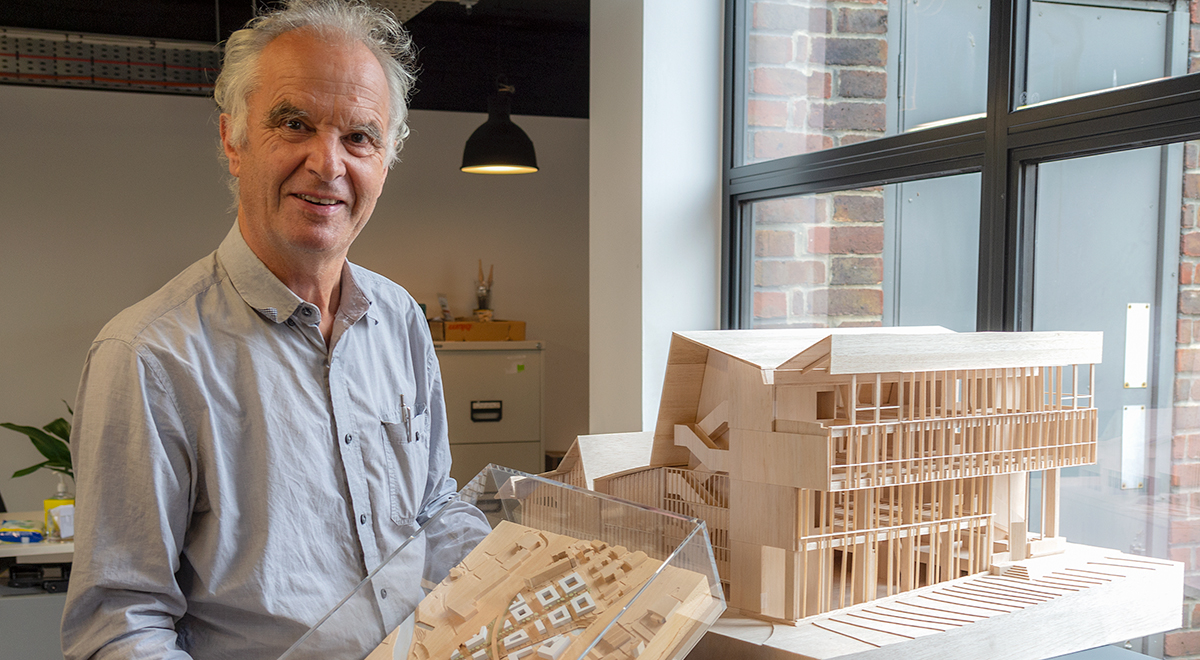Mark Whitby
50 Years in Engineering [ Act I ]

Mark Whitby is considering what sustainability means for engineering, the discipline to which he has dedicated so much of his life …
“So many engineers have seen themselves as cogs in the machine rather than part of a process,” he says, “but we’re in construction, one of the dirtiest industries there is. The reality is, it’s going to change because it has to change. People come to work with reusable water bottles and they take the train from London to Scotland rather than flying. That’s fine, but are we serious about this? We have to wean ourselves off concrete, to refine our use of the more precious materials. We need to learn to do as much with a lot less. The way to go about it is through design, and that’s engineering.”
Mark’s belief in the power of engineering to help combat the most pressing crisis of our times is informed by experience, of course, but also by his broad perspective on the profession. An enthusiast proponent of engineering history, he founded the online non-profit resource, Engineering Timelines, and is currently working on a book of engineering precedents: instances in which engineering solutions have been derived from previous innovations in a different context.
“We need to learn to do as much with a lot less. The way to go about it is through design, and that’s engineering.”
His passion for the topic betrays a fascination with the kind of thinking that has been key to his own approach, which has seen him in the vanguard of many changes to the profession over the course of his career. One example is the early adoption of CAD-CAM by his consultancy, whitbybird, in the early 1990s, when many engineering offices were still full of drawing boards.
“We were lucky to be starting just when PCs were becoming affordable — we broke ground there,” Mark acknowledges. “We were quick to embrace the technology. You have to give people the best tools if you want the best people to join you. We all know the difference between a sharp knife and a blunt one when we’re cutting tomatoes.”
Earlier still, Mark had discovered his own easy ability to communicate with architects, thus helping them find ways to achieve their most ambitious goals. As the son of an architect himself, this may seem unsurprising — Mark’s father was a partner in a successful architectural practice and had also “enjoyed engineering during the war” — but in fact, such a meeting of minds between the professions was surprisingly rare. “I knew what they were talking about,” Mark says, of his architect colleagues and clients early in his career. “I had already drooled over Lutyens’s plans and admired Viollet-le-Duc.”
“We all know the difference between a sharp knife and a blunt one when we’re cutting tomatoes.”
An exemplar of the elegant symbiosis between architectural and engineering design with which Mark’s work is associated is the Patera system designed with Michael Hopkins’ office in 1971, while Mark was working at Anthony Hunt Associates. The flexible Patera system uses exposed lightweight steel trusses to form portal frames, providing column-free internal space. Thermally insulated glass and steel panels may be arranged in any configuration, including for the creation of double height spaces that emphasize the structure’s inherent lightness.
Throughout the 1990s, Mark’s approach was increasingly in demand for high profile projects that included Nicholas Grimshaw’s impressively column-free Igus factory in Cologne (1994), Michael Wilford & Partners’ low energy British Embassy, Berlin (1995) and Eric Parry Architects’ Scottish Widows building, with its pioneering loadbearing stone facade overlooking London’s Finsbury Square (1998).
The mutual reliance between the disciplines of architecture and engineering is perhaps most perfectly expressed in bridge design. Here again, Mark’s inclination to question the logic of standard practice bore fruit in the creation of a bridge design team at whitbybird, comprising architects and engineers working together. This composite proved highly successful and deeply satisfying. It resulted, over the life of the consultancy, in the completion of more than 26 whitbybird-designed bridges in locations that include Manchester, London and Turin, and the Millennium bridges in York, Lancaster and Peterborough.
The tendency to dismiss arbitrary rules has thus contributed to Mark’s success, but it has not always made him popular — particularly with people in authority.
“I didn’t have the faintest idea what I was going to do with my life,” Mark recalls of his teenage years. “I liked sport. I was a sprint canoeist with the British Olympic team … I didn’t turn up for my chemistry A level because it clashed with high altitude training in France for the Mexico Olympics. I didn’t tell my parents and intercepted every single school report, because they were so awful.”
When Mark returned from the Olympics, where he reached the semi-finals of the K2 1000m event, his headteacher asked where he’d been (Mexico) and then, assuming he was a spectator, asked whether his parents had paid for him to go.
“No sir,” said Mark. “I was competing.”
To contemporary minds, it seems incredible that the headteacher had been so disinterested. He had even refused to sign Mark’s Cambridge application over a technicality. “Looking back, it chills me,” says Mark, of his headteacher’s myopic attitude. “But it helps thicken your skin.”
His experience of sport had a wider effect on Mark’s outlook, however. The assumption of everyone’s duty to contribute to the public good had been part of the belief system surrounding his “extraordinarily free” upbringing as a middle child of six siblings: his mother, a Webb, is directly descended from the founders of Britain’s Co-operative Permanent Building society (founded in 1884 and renamed Nationwide in 1970), and other family members were notably involved in philanthropy and in political representation. But working with his teammates for the Olympics gave Mark renewed respect for “people who did communal sport, communal music — anything that shows commitment to what you’re doing and to one another. That attitude is fundamental to a business. It’s key to recognize that while you might be good at what you’re doing, you can’t be really good without the others on the team.”
“… while you might be good at what you’re doing, you can’t be really good without the others on the team.”
On graduating from Kings College, London, Mark spent the best part of a decade working with a range of engineering consultancies and contractors. While forging relationships with both engineers and architects, during this time he also got, he says, “a very good grounding in construction”. His ideas of good management developed quickly, too: at an early job interview with a contractor, he remembers opining, “99% of people want to enjoy doing a good day’s work, and our job is to help them do that.” Pursuing his long-standing interest in flight and railways, Mark found out a great deal about “industries with strong cultures to do with safety, where I saw there were significant cultural lessons to be learnt. It’s all human. It’s about management and motivation. And profit. In engineering it’s quite possible for people to make millions at the expense of everyone, but is that attitude going to attract and hold onto very talented people?”
Setting out to “attract and hold onto” those “very talented people”, in 1983 Mark founded Whitby & Bird (later Whitbybird & Partners, and finally whitbybird), together with Bryn Bird, joined in 1985 by Mike Crane. The practice was renowned in particular for its culture, taking pride in the engineer’s role as a dynamic, solutions-based liaison between client, architect and contractor, and giving its young engineers the materials, information, support and freedom they needed to do their best work. Indeed, Mark’s impact on the culture of engineering may be where his career has had the greatest, and least remarked upon, effect of all.
“You’ve got to have a belief that it can be done better, done differently,” he observes. “Young people want to join a company where growth is completely natural, where there’s a long-term approach that can sustain their ambitions and accelerate their natural development.”
A decade on from whitbybird’s merge with Ramboll, Whitby Wood has created a similarly questing culture for an urgent new context. For many people nowadays, “a good day’s work” includes promoting and consolidating the attitudes and practices that make for a fairer, better and more sustainable world. Practice derives from culture, and achieving the behaviour change necessary for sustainable practice will require a culture that takes it seriously.
“We’re still attracting really good people, because the opportunities are phenomenal.”
As for finding solutions for sustainable construction, his confidence in the talent of engineers remains unshakeable. “Fundamentally, it’s logical: it’s based on calculations,” he says. “I don’t know what the answer is, but it’s going to be interesting.”
September 2023

